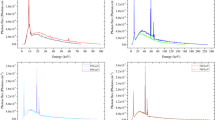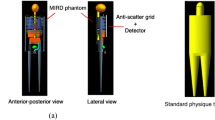Abstract
As one type of basic physical data related to the calculation of the construction of X-ray examination room shielding, we investigated the air-kerma rate 1 m from the source of the useful beam focus per unit current time product. Compared to the X-ray energy penetration values obtained in prior research, we obtained higher values. We found three causes for this discrepancy: (1) the X-ray tube total filtration (increasing total filtration reduces air kerma), (2) the tube voltage ripple percentage (increased voltage ripple reduces air kerma, and (3) the target angle (increasing the target angle increases the air kerma). On standardizing (1)–(3), we confirmed that our values mostly matched those obtained in past research. Consequently, when one employs the air-kerma rate that results from the consideration of (1)–(3), without pursuing a path of excessive safety, calculation of shielding under clinical conditions is possible.





Similar content being viewed by others
References
International Commission on Radiological Protection. 1990 Recommendation of the International Commission on Radiological Protection. Tokyo: Pergamon Press; ICRP Publication 60; 1991.
National Council on Radiation Protection and Measurements. Structural shielding design and evaluation for medical use of X rays and gamma rays of energies up to 10 MeV. Bethesda, MD: NCRP; NCRP Report, 49; 1976.
National Council on Radiation Protection and Measurements. Medical X-rays, electron beam and gamma-ray protection for energies up to 50 MeV (equipment design, performance and use). Bethesda, MD: NCRP; NCRP Report, 102; 1989.
Trout ED, Kelley JP. Scattered radiation from a tissue-equivalent phantom for X rays from 50 to 300 kVp. Radiology. 1972;104:161–9.
Trout ED, Kelly JP, Lucas AC. Broad beam attenuation in concrete for 50 to 300 kVp X-rays and in lead for 300 kVp X-rays. Radiology. 1959;72:62–6.
Matsuura T, Nishio Y, Miyake H, Asano H, Imai Y, Tsukamoto A, et al. Report based on fiscal 2005 diagnostic X-ray equipment questionnaire survey (a photography system). Jpn J Radiol Technol. 2009;65(3):323–31.
National Council on Radiation Protection and Measurements. Radiation protection in dentistry. Bethesda, MD: NCRP; NCRP Report, 145; 2003.
National Council on Radiation Protection and Measurements. Structural shielding design for medical X-rays imaging facilities. Bethesda, MD: NCRP; NCRP Report, 147; 2004.
Archer BR, Fewell TR, Conway BJ, Quinn PW. Attenuation properties of diagnostic X-ray shielding materials. Med Phys. 1994;21:1499–507.
Zamenhof RG, Shahabi S, Morgan HT. An improved method for estimating the entrance exposure in diagnostic radiographic examinations. Am J Roentgenol. 1987;149(9):631–7.
Kelley JP, Trout ED. Physical characteristics of the radiations from 2-pulse, 12-pulse and 1,000 pulse X-ray equipment. Radiology. 1971;100:653–61.
Hale J. The homogeneity factor for pulsating potential X-ray beams in the diagnostic energy region. Radiology. 1966;86:147–8.
Cranley K, Gilmore BJ, Fogarty GWA, Desponds L. Catalogue of diagnostic X-ray spectra and other data. The Institute of Physics and Engineering in Medicine, Report No. 78; 1997.
Aoyagi T, Abe S, Ogura I, Shimizu E. Radiation equipment engineering (I). Tokyo: Corona Pub. Co. Ltd; 2006.
Author information
Authors and Affiliations
Corresponding author
About this article
Cite this article
Katoh, Y., Mita, S., Fukushi, M. et al. Calculation of air-kerma rate of diagnostic X-ray generators. Radiol Phys Technol 4, 1–6 (2011). https://doi.org/10.1007/s12194-010-0097-7
Received:
Revised:
Accepted:
Published:
Issue Date:
DOI: https://doi.org/10.1007/s12194-010-0097-7




